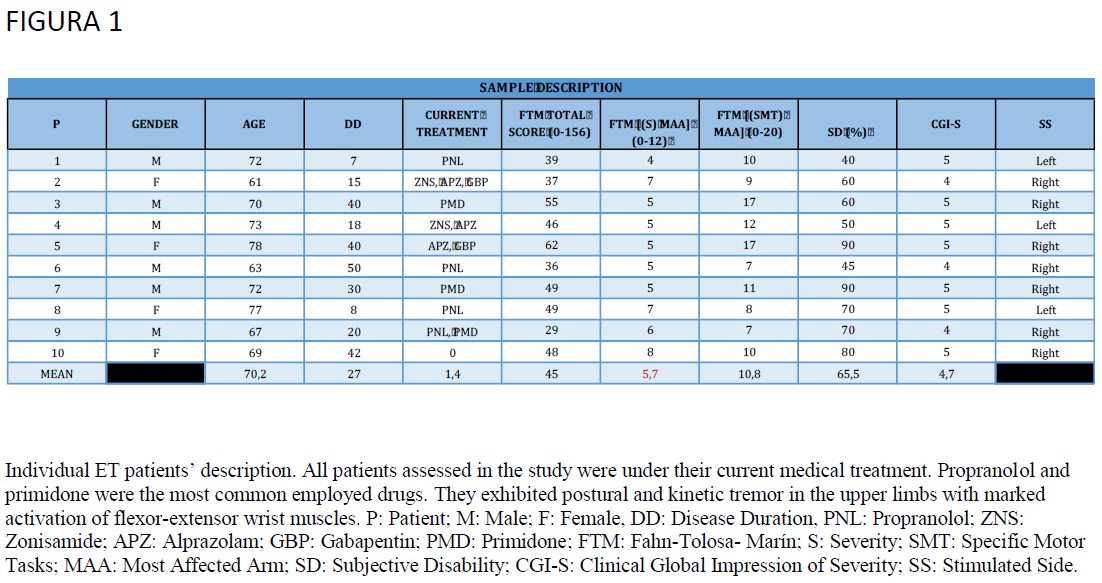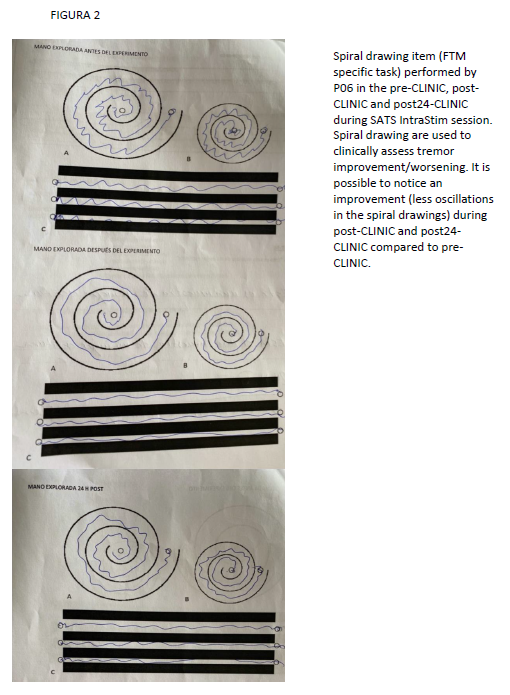Objective: To describe the preliminary clinical results of a research project on electrical stimulation of muscle afferents to reduce tremor in patients with Essential Tremor (ET).
Background: Recent studies have shown that stimulation of afferent nerve fibers below motor threshold may modulate tremor.
Method: 10 ET patients were recruited from Gregorio Marañón Hospital Movement Disorders Unit. Patients participated in 2 experimental sessions comprising: 1) sensory stimulation of wrist flexors/extensors via intramuscular electrodes (IntraStim); and 2) surface stimulation of the nerves innervating the same target muscles (SurStim). Stimulation was unilateral, in the arm most affected by tremor. Two stimulation strategies were tested: 1) selective and adaptive timely stimulation (SATS) based on EMG of the antagonist muscle; and 2) continuous stimulation (CON) of target muscles. Inertial Measurement Units (IMUs) recorded the acute kinematics changes in tremor. FTM parts A (Severity – S) and B (Specific Motor Tasks – SMT), in the most affected arm, were used to evaluate tremor before, immediately after, and 24 hours after each session. Adverse events (AEs) were monitored from the experimental session to one week after. Pain was assessed with the Numeric Visual Scale (NVS).
Results: In the acute assessment, only IntraStim with SATS achieved a significant tremor reduction of 32% (±18%) on the stimulated wrist measured by IMUs (p<0.02). SurStim with SATS showed a non-significant tremor reduction of 6 % (±16%). IntraStim with CON and SurStim with CON led to tremor aggravation (p<0.05). In the immediately-experiment evaluation, IntraStim improved FTM-S scores in 7 patients (p=0.001) and FTM-SMT in all patients (p=0.011). SurStim improved FTM-S in 5 patients (p=0.033) and FTM-SMT in 7 (p=0.022). In the 24-hours evaluation, IntraStim improved FTM-S in 5 patients (p=0.005) and FTM-SMT in 8 patients (p=0.231). SurStim improved FTM-S in 9 patients (p=0.040) and FTM-SMT in 6 patients (p=0.091). Experiments were well tolerated with no serious AEs.
Conclusion: Electrical stimulation of muscle afferents can reduce tremor severity and improve the performance of specific motor tasks in essential tremor patients. To our knowledge, this is the first report in which peripheral stimulation sessions achieved a 24 hours-maintained tremor reduction in some patients.
To cite this abstract in AMA style:
M. González Sánchez, JR. Pérez Sánchez, A. Pascual Valdunciel, F. Oliveira Barroso, S. Muceli, B. Adán-Barrientos, V. Escobar-Segura, M. Ki Jung, A. Muñoz González, A. Schneider, KP. Hoffmann, D. Farina, JL. Pons, FJ. Grandas Pérez. Electrical stimulation of muscle afferents for tremor reduction in essential tremor patients [abstract]. Mov Disord. 2022; 37 (suppl 2). https://www.mdsabstracts.org/abstract/electrical-stimulation-of-muscle-afferents-for-tremor-reduction-in-essential-tremor-patients/. Accessed October 18, 2025.« Back to 2022 International Congress
MDS Abstracts - https://www.mdsabstracts.org/abstract/electrical-stimulation-of-muscle-afferents-for-tremor-reduction-in-essential-tremor-patients/


